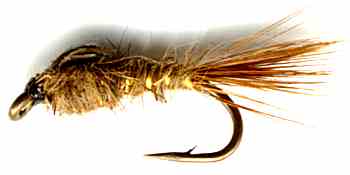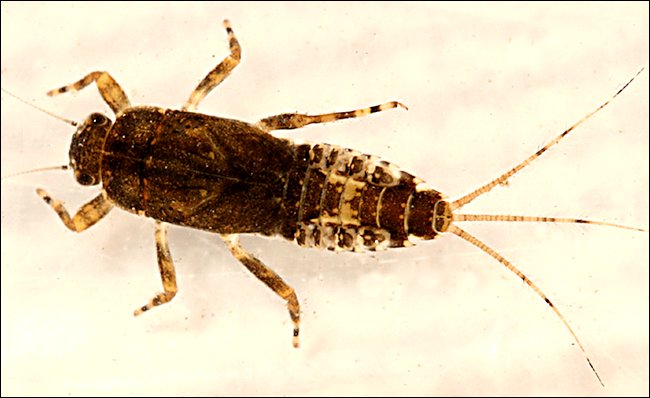Brown Gold Ribbed Hare's Ear Nymph
The Brown Gold Ribbed Hare's Ear nymph fly pattern, often shortened to just "GRHE", is ideal for mimicking mayfly nymphs. like the brown bodied Pale Morning Dun nymph, that lurk near the river or lake bed.

BROWN GOLD RIBBED HARE'S EAR FLY PATTERNS. Hook size 10 12 14 16 18 20 - $US each
Take a child's fishing net on your next trip and disturb the boulders whilst holding the net downstream. All the disturbed insects will float into your net. Examine what you find. If they are brown then choose this fly. These flies are meant to be scruffy. The fibres act as legs moving in the water as if the insect is trying to swim.
Inexperienced fly-fishermen often frighten away trout by using an unnatural looking fly pattern. This is where observing the local insects and what the fish eat pays off in catches. If you get the size shape and colour of the fly correct a presentation that generates strange behaviour can be the cause of the problem of no takes. Many fish have a good sense of smell. Soap, aftershave, sun tan cream and beer can all contaminate a fly when you are tying it on. A weird unnatural smelling fly will spook fish. I always 'wash' my hands in the river or lake water before tying on a new pattern.

If you are fly fishing in an area which is popular, the sight of humans walking near the river or lake edge will not spook fish. if you fish in a more wild and remote location you must try to use local cover to hide your movements so as not to make the fish jittery and swim away. Small Young trout will eat often on smaller morsels. Their bodies are on a constant growing spurt so need fuel to develop. Older fish are more choosy and go for bigger targets that will satisfy their hunger more easily. If you are dealing with smaller young trout then use a smaller fly. You will have more luck landing larger trout using a bigger hook sized fly.
Trout can become selective feeders if there is an abundant food supply. This is when you need to do your research and find out the shape and size of their most favourite food. Ask local anglers and spoon a fish to see what it has been eating. A Brown Gold Ribbed Hares Ear nymph fly is also a good choice on rivers that have been stocked with trout reared in stew-ponds. They have been fed at an early age on high protein dry food pellets. The brown scruff dressing of this fly can be mistaken for a pellet and fooled a number of good sized fish.
Things to look for when bank fishing in Spring
When going to a new fishery in the early part of the season you need to study the layout to help you get the best results. Walking the lake before you choose your spot really helps. Don't try and fish over gravel beds. Trout may be trying to cut redds and egg laden females will be looking for places to lay eggs. They will be trying to mate and not interested in taking your fly. Trout are happier if they have a depth of water below them so they can escape if they are spooked. Look for where the water drops off, deep holes, shelves and springs. The trout like the comfort of having different options if threatened by holding above them. If there is a deep drop away from the bank side that levels out into a shelf this is another preferred location because the weeds find it easier to grow here and the insects like this environment. This provides a food fish source. Find weed and you will have found a rich aquatic habitat. Look for locations with bushes, long grasses or reeds that can help disguise your silhouette. It helps to wear dark natural colored clothing. Leave your red Hawaiian shirt at home. If there is a headland or point of land that juts out try fishing form there because they normally have deep water on either side. If a stream is coming into the lake it will be slightly warmer than the deep cooler water in the lake. This attracts some insects which in turn attracts the fish. Try fishing in the general area
Hoglice and the Gold Ribbed Hares Ear nymph
The hoglouse or water louse (Asellus sp) is a small, drab coloured aquatic crustacean closely related to the terrestrial woodlouse most of us find in our gardens. They are very similar in size and colour.
The hoglouse is found in lakes and slow moving rivers. Being poor swimmers, they prefer to remain close to the bottom where they scuttle about amongst the decomposing vegetation. Trout carp and grayling love them yet you hardly here hoglouse mentioned in the fly fishing press. I suppose the name just does not sound sexy.
You do not hear fishermen down the pub or on the water bankside boast that they tied a hoglouse imitation. This is strange as this food source is available to the fish all year round. Even in the depth of winter when other food sources are hard to find this crunchy little snack is available to be found and devoured.
Being dull, mottled-brown in colour the hoglouse is extremely well camouflaged. It is it's only line of defence for such a slow moving creature. As a crustacean, hoglice have no nymph or pupa stage.
The normal wisdom is that trout feed on hoglice in cold weather. Fishing a fly that imitates a hoglouse close to the bottom can be effective right through into March and April, after which other insect activity becomes pronounced and seductive. There are exceptions to this. Five years ago I was fishing at Rutland Water when I caught a large brown trout over 30 feet down. It had been feeding on hoglice throughout the hot summer.
You do not realise it but you have probably already been fishing with a fly that is a good imitation of a hoglouse. Most fly fishing anglers have used a Gold Ribbed Hares Ear nymph during their fishing career. It is perfect for the job.
The key is to fish it on the point, deep and very slow. The natural insect crawls very very slowly. It only has little legs. The scruffy fibres that stick out the side of a GRHE nymph move around in the water and look like the little legs on the natural insect. If your fly is tied neatly use the hook point from another fly and pick out the fibres.
I use a slow figure of eight retrieve. Even though it needs to be fished hard on the bottom, rather than use a stinking line, it is more effective to use a floating line or sink tip line and a long leader. This allows the fly to be worked over any obstructions on the bottom rather than simply snagging them.


Fly Fishing books

